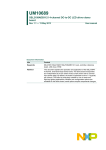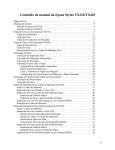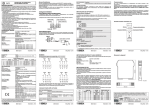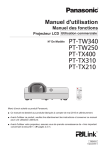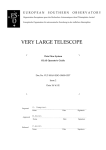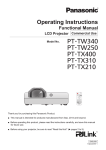Download User Guide - SEM210 - Global Measurement & Controls
Transcript
INDEX TX210 SERIES Programmable In-head Universal Temperature Transmitter Global Measurement and Control Ltd Tel: +44 (0)115 946 7441 Email: [email protected] Fax: +44 (0)115 946 7442 Web: www.globalltd.co.uk SECTION CONTENTS PAGE NO. 1.0 2.0 3.0 DESCRIPTION SPECIFICATION INSTALLATION 1 1-5 6-7 1.0 DESCRIPTION 2.3 MILLIVOLT INPUT*5 The transmitter is a second generation 'Smart' in-head temperature transmitter that accepts any commonly used temperature sensor, slidewire transducer or millivolt signal and converts the output to the industry standard (4 to 20) mA transmission signal. The software package RCPW can be used to program the unit. Minimum Span*¹ Basic Measurement Accuracy*² Input Impedance Thermal Drift Zero Span 2.0 SPECIFICATION @ 20 ºC 2.1 RTD INPUT (Pt100) Sensor Range Minimum Span*¹ Linearisation Basic Measurement Accuracy*² Thermal Drift Zero Span Excitation Current Maximum Lead Resistance Lead Resistance Effect Input Range Characterisation (-200 to 850) ºC (18 to 390) Ω 25 ºC BS EN60751 (IEC 751) BS 1904 (DIN 43760) JISC 1604 CUSTOM [X]*³ ± 0.01 % FRI ± 0.05 % Rdg (FRI = Full Range Input) 0.008 ºC/ºC 0.01 %/ºC (300 to 550) µA 50 Ω/leg 0.002 ºC/Ω Voltage source (-10 to 75) mV Linear Custom [X]*³, 4th order polynomial 5 mV ± 10 µV ± 0.07 % Rdg 10 MΩ 0.1 µV/ºC 0.01 %/ºC 2.4 SLIDEWIRE INPUT*5 Input Resistance Range Characterisation Minimum Span*¹ Basic Measurement Accuracy*² Temperature Drift 3 wire potentiometer (10 to 390) Ω (end to end). Larger values can be accommodated by external resistor. Linear Custom [X]*³, 4th order polynomial 5% 0.1 % FRI 0.01 %/ºC 2.5 OUTPUT 2.2 THERMOCOUPLE INPUT SENSOR RANGES Thermocouple Type TC Type K TC Type J TC Type T TC Type R TC Type S TC Type E TC Type L TC Type N TC Type [X]*³ Measuring Range*4 ºC -200 to 1370 -200 to 1200 -210 to 400 -10 to 1760 -10 to 1760 -200 to 1000 -100 to 600 -180 to 1300 User defined Linearisation Basic Measurement Accuracy*² Thermal Drift Zero Span Cold Junction Error Cold Junction Tracking Cold Junction Range BS 4937 / IEC 584, EN60584 ± 0.04 % FRI ± 0.04 % RDG or 0.5 ºC (whichever is greater) 0.1 µV/ºC 0.01 %/ºC ± 0.5 ºC 0.05 ºC/ºC (-40 to 85) ºC Page 1 Minimum Span*¹ ºC 50 50 25 10 100 50 25 50 Output Range Maximum Output Accuracy Voltage Effect Thermal Drift Supply Voltage Maximum Output Load (4 to 20) mA (> 3.8 to < 20.2) mA 23 mA ± 5 µA 0.2 µA/V 1 µA/ºC (10 to 35) V [(Vsupply -10)/20] kΩ (e.g 700 Ω @ 24 V) *NOTES: 1. Any span may be selected, full accuracy is only guaranteed for spans greater than the minimum recommended. 2. Basic measurement accuracy includes the effects of calibration, linearisation and repeatability. 3. Customer linearisation requirements are available pre-programmed at the factory, contact your supplier for details. 4. Consult thermocouple reference standards for thermocouple material limitation. 5. If the unit is to be configured for either millivolts or slidewire input, the following procedure should be followed. Configure unit for RTD with BS1904 linearisation (Not EN60751) and up load to unit. The unit can now be configured for millivolts or slidewire input. Page 2 2.6 GENERAL Input/Output Isolation Update Time Time Constant (Filter Off) Filter Factor Programmable Warm up Time 500 VAC rms (galvanically isolated) 250 ms maximum < 1 s (Time to reach 63 % final value) Off, 2 s, 10 s or adaptive 120 s to full accuracy ENVIRONMENTAL Ambient Operating Range Ambient Storage Temperature Ambient Humidity Range (-40 to 85) ºC (-50 to 100) ºC (10 to 90) % RH non condensing APPROVALS EMC BS EN61326 MECHANICAL Enclosure Material Weight Dimensions DIN standard terminal block size ABS 35 g (43 x 21) mm COMMUNICATIONS PC Interface Minimum Output Load Maximum Cable Length Configurable Parameters offset Comms Protocol Data Rate COMMON INFORMATION Global Ltd TX210 Manufacturer Type Number 0891 CE Marking RS232 via configurator 250 Ω for 'In loop' programming 1000 m Sensor type: Burnout: ºC/ºF: Output: Hi/Lo: Filter: Tag: User ANSI X3.28 1976 1200 baud 2.7 SEM210X VERSION - FOR USE IN POTENTIALLY EXPLOSIVE ATMOSPHERES Explosive Protection Marking (TYPE ia) INTRINSIC SAFETY II 1 Equipment group and category G Type of explosive atmosphere (Gas) EEx ia IIC T4..T6 Intrinsic safety information TRL03ATEX21032 X Certificate reference 2.7.3 SPECIAL CONDITIONS FOR SAFE USE 2.7.1 ATEX CERTIFICATE The TX210, has been issued with a EC-type examination certificate, confirming compliance with the European ATEX directive 94/9/EC for: As indicated by the Certificate Reference "X" suffix, special conditions apply for safe use for both intrinsic safety and energy limitation applications. They are as follows: ZONES, GAS GROUPS, AND T RATING. When connected to a approved system the SEM210X may be installed in: INTRINSIC SAFETY II 1 G EEx ia IIC T4…T6. The equipment bears the Community Mark and subject to local codes of practice, may be installed in any of the European Economic Area (EEA) member countries. The SEM210X housing is coloured light blue to identify the equipment as suitable for Hazardous area use. The equipment must be installed and maintained in accordance with local requirements for electrical equipment for use in potentially explosive atmospheres, e.g EN60079-14 & EN60079-17. This instruction sheet describes installation which conforms with BS EN60079-14 & BS EN60079-17 Electrical Installation in Hazardous Areas. When designing systems outside the UK, the local Code of Practice should be consulted. Page 3 Zone 0 Zone 1 Zone 2 Explosive gas air mixture continuously present Explosive gas air mixture likely to occur in normal use Explosive gas air mixture not likely to occur and if it does, it will only occur for a short time. Be used in gas groups: Group A Group B Group C Propane Ethylene Hydrogen Page 4 Allowable temperature classification/ambient temperature: 3.0 INSTALLATION INTRINSIC SAFETY (Type ia) 3.1 MECHANICAL CLASS T1 T2 T3 T4 T5 T6 450°C 300°C 200°C 135°C 100°C 85°C AMBIENT TEMPERATURE RANGE °C -25 to 85 -25 to 85 -25 to 85 -25 to 85 -25 to 50 -25 to 40 The transmitter is mounted using two 5.5 mm diameter holes, on standard 33 mm fixing centres and will fit a DIN standard termination head. The transmitter should be installed with adequate protection from moisture and corrosive atmospheres. Care must be taken when locating the transmitter to ensure the ambient temperature remains within the specified operating range. Figure 1 shows the mechanical layout and a typical application of the transmitter mounted inside a termination head enclosure, with sensor wires entering through the centre of the transmitter body. 2.7.4 ENVIRONMENTAL PROTECTION This equipment must be housed in an enclosure which provides a degree of protection of at least IP54. The enclosure must be suitable for the atmosphere and environment in which it is installed. (e.g. If of a plastic material, must be resistant to chemical corrosion, UV light, temperature, humidity, etc). Figure 1 24.00 mm Ø33.00 mm Centres 2.7.5 MAINTENANCE This intrinsically safe equipment contains no user serviceable, adjustable or replaceable parts. No attempt should be made to repair a faulty TX210X transmitter, all units must be returned to the manufacture for repair or replacement. Attempt service or replacement of parts may invalidate the explosive protection features of the equipment. Ø44.00 mm 2.8 CONNECTION DIAGRAM They equipment must be electrically connected as shown below: HAZARDOUS AREA Centre hole Ø6.3 mm SAFE AREA SEM210X BARRIER 3 Vo lo Po 4 SENSOR DC SUPPLY Figure 2 ENCLOSURE + 1 5 30 V 100 mA 750 mW 2 EARTH SEM210X WORKING PARAMETERS Ui 30 V Ii 100 mA Pi 750 mW Ci 10 nF Li 0 µH - CABLE ENTRY (4 to 20) mA LOOP Page 5 Page 6 3.2 ELECTRICAL ALSO AVAILABLE: Connections to the transmitter are made to the screw terminals provided on the top face. No special wires are required for the output connections, but screened twisted pair cable are the most suitable for long runs. It is recommended that screened cable is used for the three input signal wires for cable runs greater than one metre. All three input wires must have the same core diameter to maintain equal lead resistance in each wire. A Ø4.5mm hole is provided through the centre of the transmitter to allow sensor wires to be threaded through the transmitter body direct to the input screw terminals. The screw terminals have been designed to allow all connection wires to enter from an inner or an outer direction. Figure 3 shows the method of connection to provide a (4 to 20) mA current loop output. The Pt100 sensor shown would normally take the form of a probe assembly with a three wire connection. The output loop has a voltage power supply used to provide loop excitation. The load symbol represents other equipment in the loop, normally indicators, controllers or loggers. Care must be taken when designing the (4 to 20) mA circuit to ensure that the total voltage requirements of all the equipment in the loop added together, does not exceed the power supply voltage. If a number of instruments are connected in the loop, ensure that only one instrument is tied to ground. Grounding the loop at two points will cause a short circuit of part of the loop leading to measurement errors. Smart In Head Temperature Transmitters DIN Rail Mounted Temperature Transmitters Panel & Field Temperature Indicators Temperature Probes Trip Amplifiers Signal Conditioners And many other products For further information on all products: To guarantee CE compliance, sensor leads must be less than 3 m long and the transmitter housing should prevent access to the transmitter during normal operation. Global Measurement & Control Ltd Figure 3 - + 3 -mV TC 4 3 4 4 4 Tel: +44 (0)115 946 7441 MILLIVOLT Email: [email protected] Pt100 Rx 3 3 + 5 5 SLIDEWIRE - + Pt100 (10 to 35) VDC T/C (4 to 20) mA - LOAD + + 1 2 POWER SUPPLY - * Fit Rx for all potentiometers with end to end resistance > 390 Ω. Such that total end to end resistance is > 200 Ω < 390 Ω. Page 7 Page 8 Fax: +44 (0)115 946 7442 Web: www.globalltd.co.uk






